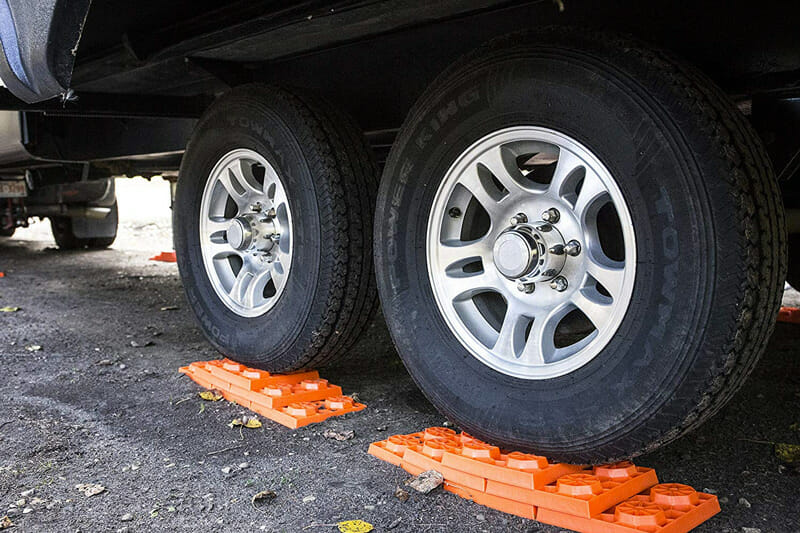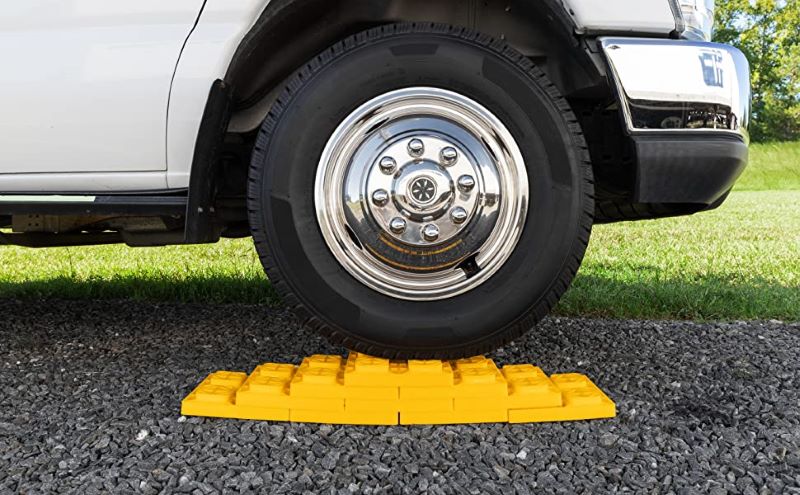It may be while they’re caravanning or just parked in their own driveway, but every RV, caravan, and motor homeowner eventually has to park on unleveled ground. For caravan owners with either automatic or self-levelling systems on their vehicles, overcoming unleveled ground is as easy as pushing a button. For the more conventional rigs, however, getting levelled requires a bit more time and effort.
Learning how to level their rig is one of the most basic skills an RV owner has to master. It doesn’t take years of experience to know how to properly trim a 10-tonne caravan or motor home, though. It takes having the right equipment for the job, and veteran and full-time RV’ers know that chocks are the key to making levelling as effortless as possible.
Effortless Levelling With Wheel Chocks
If the urgency for levelling a caravan doesn’t seem particularly obvious to the beginner or an invited guest, it generally doesn’t take long for them to understand why it has to be done. If you can imagine trying to keep a glass of water from sliding off of an unbalanced table, that’s precisely what happens with everything when an RV isn’t levelled. The solution though is as simple as using heavy-duty caravan chocks and levelling ramps to raise the vehicle’s wheels to achieve a level height.

If the picture of the sliding glass seems a little exaggerated, then it’s worth considering that there’s a long, and infinitely more serious list of problems that can result from not leveling an RV, including:
- Inaccurate fluid tank readings and plumbing difficulties;
- Refrigerator damage due to inadequate coolant circulation;
- Inability to safely extend or retract sliding extensions;
- Costly damage to doors, windows, and interior cabinetry; and,
- Structural stresses can lead to irreparable frame damage.
By using RV levelling ramps and blocks, caravan and other motor home owners can ensure their rigs are parked on a level plane at all times, without resorting to wobbly scissor jacks or improvised wooden ramps to do the lifting. High-quality, injection-moulded RV ramps and chocks are the simple, affordable, and most importantly, safe way to make levelling effortless.
Chock Types for All Uses
When it comes to genuine Australian-made levelling ramps, UV-resistant polyethylene is hands-down the preferred material. It’s a polymer that’s durable, lightweight, and ideal for a full array of levelling products, from caravan levellers and chocks, to interlocking levelling blocks. No one wants to spend a heap of time manually levelling a caravan, though. Rig owners want the process to be as problem-free as possible, so it’s not uncommon to keep a variety of different ramp and caravan chock solutions onboard to get their rigs levelled. Combination stepped caravan ramps with integrated wheel chocks are an innovative approach to levelling that features a removable rear section to help simplify levelling dual axle RVs. These RV levelers are typically designed to:
- Level both single and dual axle rigs;
- Support up to 5 tonnes per axle; and,
- Accommodate step heights of 40mm, 70mm, and 100mm.
And for parking situations that require a levelling solution to be more inventive than innovative, rig owners also like keeping a supply of stackable, square RV levelling blocks on hand. These are basic interlocking blocks that won’t sink into the ground and can be combined for all kinds of uses, including:
- Levelling single or dual axle rigs;
- Supporting RV stabilizer pads or jockey wheels; and,
- Stabilizing jack stands and other campsite gear.
From one-size-fits-all caravan wheel blocks to key-locking wheel stabilizers, there’s a huge selection of sturdy, stowable products available for RV owners to choose from to level their rigs. Having the proper gear is the bulk of the job; the rest is just a matter of finding a location where the ground is stable, where there’s sufficient space to maneuver, and then getting the caravan into position.

How Chocks are Used for Leveling
With only a bubble level and a bit of patience, leveling is a reasonably straightforward task. It’s performed first from side to side using the RV levelling chocks, and then from front to rear using the vehicle’s jockey wheel or stabilizers.
Proper side-to-side levelling requires that all of an RV’s wheels are solidly supported by a stabilizing surface, with at least one wheel remaining on the actual ground. And although there can be variations in how the job is done depending on the terrain, the general procedure is still the same.
- A bubble level is placed on the RV’s tongue to determine which side of the rig needs lifting.
- The RV wheel levelling blocks are placed by the wheels to be raised, and the rig is pulled forward to clear the position.
- The blocks are slid into the exact position where the wheels were just moved from.
- The rig is backed onto the blocks and checked for levelness, or the process is repeated until the desired height is achieved.
- Once the rig is sufficiently level, the wheels are chocked, and it’s time to work on front-to-rear levelling.
Levelling front-to-rear is inherently simpler than side-to-side because rigs typically have adjustable jockey wheels, and require the use of the bubble level to get the correct alignment.
- An RV stabilizer block is placed under the rig’s tongue jack or jockey wheel.
- The caravan is unhooked from the towing vehicle.
- The direction of the bubble level is reversed.
- The rig’s level is adjusted atop the stabilizer block using either the tongue jack or jockey wheel, and the job’s done.
The Final Word
At the end of the day, self-levelling systems may be convenient, but not every RV owner wants to invest thousands of dollars in refitting their rigs with an electric system that could experience its own problems, when there’s an entire range of options available that work every time, at only a fraction of the cost.
Heavy duty, polyethylene caravan chocks and levelling ramps are the way to go when it comes to safely and quickly get an RV, caravan, or motor home levelled. If you already own a rig, or are considering buying one that either doesn’t have automatic leveling, or you simply want a reliable backup solution, chocks are the way to go.
























